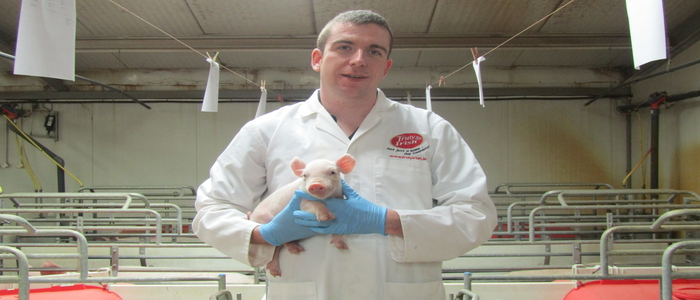Irish pig producer and consultant Shane McAuliffe sets out what 2021 has in store for the Irish pig industry.
According to Chinese astrology, 2021 is the Year of the Ox. Having an honest nature, oxen are known for diligence, dependability, strength and determination.
While we are more than glad to see the back of 2020, any of those attributes for 2021 would be more than welcome.
This time last year we were predicting an average Irish pig price of €2.15 (£1.87)/kg for 2020. By year-end, the average price for the year was €1.73 (£1.51)/kg. So in summary, it was indeed a profitable year, especially when you compare it to the 5 year (2016-2020) average price of €1.58 (£1.37)/kg.
At the time of writing, our price is €1.52-€1.54 (£1.32-£1.34)/kg, which is well above the EU average of €1.28/kg. However, the cost of production is rising as feed prices currently remain strong.
In 2020, Irish pig supplies increased by 4% to 3.9 million (317,000 tonnes) and, in line with EU pigmeat exports, Irish exports reached a record high, with primary pigmeat shipments increasing by 3% to 234,000 tonnes, worth €590 million.
For the first time ever, the UK was not the number one destination for Irish pigmeat as this title now belongs to China. Irish pigmeat shipments to Asia now account for 47% of total volume. The UK is still an important partner, however, with 23% of the export share, while exports to mainland Europe also grew.
Our 2021 predictions will be driven by three main factors; Chinese demand, the effects of COVID-19 and Brexit. The Teagasc prediction for the year is a price of €1.58 (£1.37)/kg.
Despite the ongoing investment in high rise pig farms we are seeing in the media, China’s production is still challenged and is predicted to reach 80% of pre ASF levels in 2021. However, there are many who predict that it may take much longer than that.
Other Asian countries are still affected by ongoing ASF outbreaks and there is a strong European retail demand forecast. Brexit has been a concern for quite some time, but it is only now that we seem to be getting an idea of how it will affect the Irish pig industry.
From April 1, all pigmeat leaving Ireland entering the UK mainland must have more detailed third country veterinary documents. This will cost time and money, possibly up to €200 per truckload.
The Northern Ireland protocol will allow the current situation to continue rather seamlessly with the current veterinary certificates and farmer declarations. There should not be any delays getting pigs slaughtered, but live export will be more onerous.
Irish pigmeat may also have an opportunity with the UK market. Belgium, Danish, Dutch and German exporters are facing additional costs and delays at UK ports of entry. Volumes are already down because of this and Irish pigmeat may help to fill this gap in the UK.
Further progress is being made with Pig HealthCheck, which I mentioned in my last article. A database will link all data from the programme’s five activities and farmers will be able to access a digital dashboard that will analyse all the data for their herd and benchmark against national averages.
While my regular pre-COVID international travel came to an abrupt end, I did get to fly to Dublin in December to appear as a special witness to the Oireachtas Joint Committee on Agriculture. I was there to stress the importance of increased vigilance on protecting our island from ASF. It was agreed that the issue would be raised in Stormont so we can work on an ‘all-island’ approach.
I have been busy speaking at other online events, including a presentation on pig farm biosecurity during National Animal Health Week, which was a great opportunity to showcase Irish pig farming to the general public.
The usual Irish Pig Health Symposium will be online year (dates announced soon), giving UK readers the opportunity to view topical presentations from renowned speakers, so keep an eye out!
Closer to home, my part-time role with EASYFIX is coming to an end and I have thoroughly enjoyed developing their hugely popular range of pig enrichment all over the world for the last three years.
But now I need to focus more time on our own pig farms and we have many different research trials coming up, so all that data will keep me busy!
- Shane’s family produces 50,000 pigs per year for the Truly Irish brand. He is secretary of the Irish Pig Health Society, secretary of the Irish branch of the European Pig Producers and sits on the Irish Farmers’ Association’s National Pig and Pigmeat committee. He also works part-time providing consultancy in sustainable pig farming and welfare.
- You can follow Shane on Twitter: @ShaneMcAuliffe1




